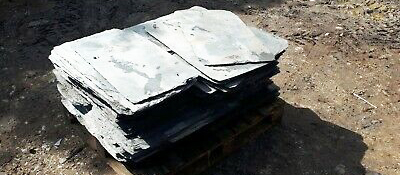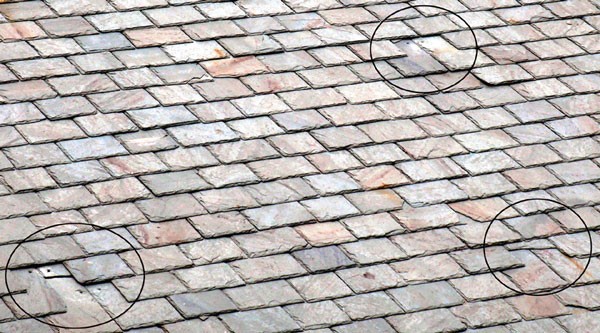A reprint of an article about Slate Roofs & the Importance of “Attic Stock” published by Brian Stearns, the president & founder of Alpine SnowGuards, in Slate Roof Quarterly.
The term “Attic Stock” is recognized by too few people in the slate industry. Attic stock is a reserve supply of roofing slate that is left on the job after the roof installation has been completed. During the slate roofing hay day of the early 1900’s, “attic stock” was something that everyone who owned a slate roof had. The reserve was left on site because building owners understood that slate roofs required routine maintenance, and all parties involved understood the need to have repair shingles available that would match those installed. The most logical way to accomplish this reserve was to keep extra material on site, typically 2% of the total roof area, for future use. This reserve material was often stored in the attic of the building and therefore became known as “attic stock”.

Attic stock has become a thing of the past. One reason is that so few of the parties involved with a slate roofing project today understand the long-term maintenance requirements of a “lifetime” roof. A second reason may relate to our modern bidding process. A contractor who plans to provide additional material for reserve purposes, if it isn’t specifically called for in the bid, could lose the job. Not planning for attic stock is a mistake. Unfortunately, the problem does not become apparent until after the roof has been completed.
Slate has a reputation for being a “lifetime” roof. It can be a lifetime roof if it properly maintained and cared for. A Rolls-Royce or Mercedes-Benz might be a lifetime car but you still need to change the oil, replace the tires as needed and routinely check the running gear. Doesn’t it make sense that for some- thing as important and expensive as a slate roof that you would exercise the same responsibility of owner- ship? A slate roof when properly installed, using S-1 grade slate and the appropriate flashings, when properly and correctly maintained, will last more than a lifetime. But the owner has a responsibility to see that the maintenance is carried out properly and routinely.

The best installed slate roofs will begin to “shed” slates during the first 1-2 years. In some cases, slate is broken by the roofer as the roof is being installed. If the break or crack is concealed by the next course of slate, the roofer doesn’t always see the damage during the initial installation. Over the course of approximately one year, vibration caused from wind, doors opening and closing, internal movement, mechanical devices, etc., will shake the roof enough to dislodge most of these hidden damages. (In chapter 11, page 165 of The Slate Book, there is more about this phenomena).
This “Shedding” characteristic is common primarily with slate but applies to some type of tile roof installations as well. The roofers who install these roofs and have experience anticipate this. They will let the owner know to also anticipate this and they will return approximately one year later and replace any of these missing pieces. Problems seem to develop when the roofer is as surprised as the building owner when this “shedding” occurs. The sense of confusion and frustration by the roofer leads the building owner to question if the roofer really knew what he was doing to begin with.

I highly recommend that the roofer and building owner discuss and fully understand this “shedding” phenomena prior to starting the roof. Once both par- ties understand this issue, it is important to negotiate, as part of the original contract, terms to repair these pieces. In fairness to both parties, random slate missing in the field of a roof usually falls within this “shedding” description. However, slate is often broken by other trades people and blamed on the roofer. All parties should do their best to avoid foot traffic on the roof by other trades. If another trade needs access to the roof, contact the roofer and ask for his assistance. Be willing to pay the roofer to repair damages caused by other trades. Slate will break. Expect it to.

For all parties involved with the planning and execution of a slate roof installation plan to specify that at least 2% of the original slate roofing material be left on site as “Attic Stock”. Work into the bid documents how and where the building owner wants this reserve material stored. Be sure to keep records of where this material is stored. Attic stock will save the building owner money over the life of the building.
I was once asked to look at repairing a large group of church buildings in the New York City area. As we looked at each building, the owner’s representative began to realize that simply finding slate and tile to match the existing shingles was going to be a very expensive part of the project. So, I mentioned that during the era of these roofs being installed everyone kept an “attic stock”. After some explanation he decided that we should ask the maintenance person at the next stop if they knew of such material reserve. Sure enough, it was hidden in the basement. The maintenance man guarded it carefully so that no one took it to paint on. We then back tracked and found materials at all but one location. The point here is that this was always done in years past. All parties understood the need to have matching repair shingles on hand and on site. I didn’t get this work. My bid was too low because I had proposed using this existing attic stock. I was the only contractor who didn’t figure material cost. All of the other bidders figured and used new material which didn’t even come close to matching the original slate.
If your building does not currently have attic stock then now is the time to begin researching what slate (or tile) you have on your roof, calculating what you need for quantities, and most importantly, purchasing material to establish a reserve stock for future use. If you wait until you need to make repairs on the roof, you will either need to delay repairs until the right material is found, repair with material that does not match, or pay exorbitant prices because you need the material right away. Never assume that your material is readily available.
Identifying what material is installed on the roof is a relatively easy process. With a small chip of slate or tile, along with a photo or two of the roof, an experienced individual can identify what your existing roof is and where it is likely to have come from. From there they can direct you to suppliers in your area.
Editor’s footnote: The “attic stock” method applied to slate roofs 20+ years ago. Today it also applies to synthetic shingles, metal shingles and any roof application that may be subject to damage.
We keep snow in its place
888.766.4273
Sign up to start using our Online Project Calculator for an immediate layout and project pricing!
Subscribe to our monthly newsletter and keep up on the latest industry and Alpine news, products, and upcoming events!
Alpine SnowGuards designs, engineers, and manufactures snow management systems from our facilities in Morrisville, VT. We work closely with leading roofing contractors, engineering firms, developers, solar installers and roofing manufacturers to ensure we deliver quality products that do what we say they’ll do. Alpine SnowGuards can help a building qualify for LEED® credits

